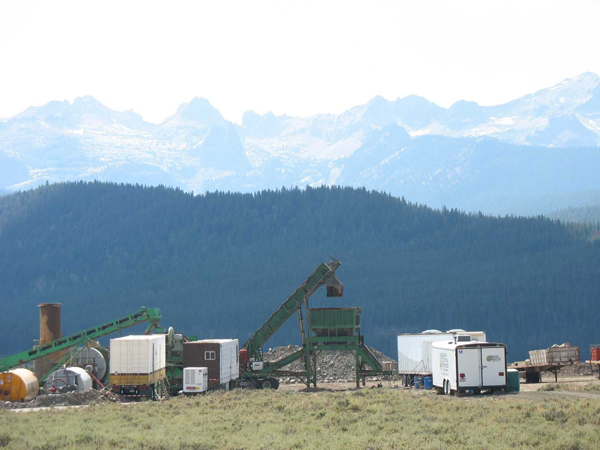A plan to swap out several parcels of state land in the heart of the Sawtooth Valley for federal lands near Tamarack Resort has been stopped cold by the ski area's financial woes.
Described as a "win-win" by its backers, the land swap would have exchanged three 640-acre parcels owned by the Idaho Department of Lands inside the Sawtooth National Recreation Area for U.S. Forest Service lands next to the McCall-area ski resort, which opened in 2004. Ski area representatives sought the exchange to allow them to expand.
But that was all before the resort's owners declared bankruptcy earlier this spring, leading the ski area's financial backer, Zurich-based Credit Suisse, to take over as creditor. Tamarack is currently operating under receivership.
Recently, the courts granted the receiver, San Diego-based Douglas Wilson Cos., $10 million to winterize portions of the construction project that haven't been completed and to prepare the ski area for a December opening.
All other functions of the ski resort, including talks aimed at moving the proposed land exchange along, are off the table for now. Resort managers have said they will hire a small crew to operate the ski area this winter.
A push to swap the three state parcels in the SNRA for Forest Service property elsewhere began in June 2006 when the Idaho Transportation Department plowed through a field of sagebrush to create a gravel pit on one of the parcels near Fourth of July Creek Road. At the time, SNRA officials expressed dismay, saying they'd been caught off-guard by the work.
The gravel pit, which ITD continued to operate as a source of gravel in 2007, is approximately 45 miles northwest of Ketchum and one mile east of state Highway 75. Gravel from the site was used for an eight-mile resurfacing project on state Highway 21 near Banner Summit.
ITD did not operate at the Fourth of July gravel pit this summer.
Of the two other state-owned parcels in the Sawtooth Valley, one is near the intersection of Alturas Lake Road and the other is near the Sawtooth Fish Hatchery south of Stanley.
Unlike on other lands inside the 756,000-acre SNRA, federal officials do not have control over how the state parcels are used. The law passed by Congress to establish the SNRA in 1972 exempted the state-owned land from regulations that apply to other lands.
"The state retained its sovereignty," said Robert Hayes, president of the Sawtooth Society, which works to preserve the fish, wildlife, scenic and recreational values of the SNRA. "That is not in question."
At the same time, state law requires the department of lands' parcels to be used to generate income for public schools.
Talks aimed at finalizing the exchange between the state and Forest Service were an attempt to stop further work at the Fourth of July parcel and prevent development of the other two.
A fourth parcel, located downstream from Stanley along the Salmon River, is included in a separate land exchange proposal under Rep. Mike Simpson's Boulder-White Clouds wilderness bill, the Central Idaho Economic Development and Recreation Act.
The sense of urgency that the exchange's backers feel is tied to a mineral lease that the Idaho Transportation Department has on the three parcels. Though ITD officials haven't announced plans to reopen the Fourth of July site or begin working the other parcels, they can legally do so if the need for gravel arises, Hayes said.
"There's always the potential they will open up the other sites," he said.
He said the Sawtooth Society is working hard to avoid the need for that to happen. He described gravel mining as "antithetical" to the purpose of the SNRA.
Hayes said people who recreate in the Sawtooth Valley each year don't want the area's famous views spoiled. In 2006, passersby said work at the Fourth of July Creek site was an eyesore that detracted from the area's scenery.
Due to the unexpected delay caused by Tamarack's financial difficulties, the Sawtooth Society and SNRA and ITD officials are now seeking a short-term solution to avoid work at the three parcels. Over the summer, a geologist with the Sawtooth National Forest identified three possible sources of gravel inside the SNRA that are not as obvious to the public.
One of those sites has already been thrown out due to significant resource issues, said SNRA Area Ranger Sara Baldwin.
Baldwin said she's given the ITD the go-ahead to investigate the other two sites at the southern end of the Sawtooth Valley to determine if they're suitable sources of gravel. Baldwin said the ITD's District 4 engineer, Devin Rigby, has assured her that he will give her a year's notice if the department intends to resume operations at any of the three sites.
As for the Tamarack land swap, she said everyone's pretty much in "a holding pattern."
"There's still hope for that," she said.
But if that doesn't work out, she said, SNRA officials could negotiate a swap using different parcels of federal land.


 Backers of a delayed land swap between the Idaho Department of Lands, which owns the site of this controversial gravel mine in the Sawtooth Valley, and the U.S. Forest Service still hope to find a way to bring several parcels of state-owned lands in the valley into federal ownership.
Backers of a delayed land swap between the Idaho Department of Lands, which owns the site of this controversial gravel mine in the Sawtooth Valley, and the U.S. Forest Service still hope to find a way to bring several parcels of state-owned lands in the valley into federal ownership.



































